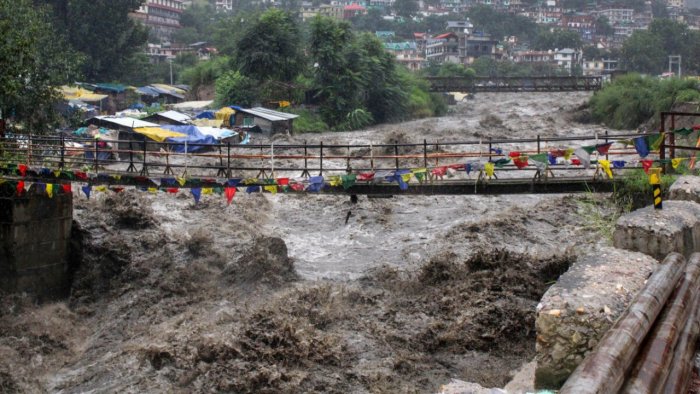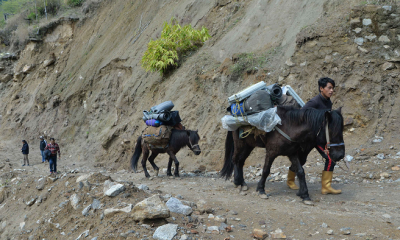Foreign News
Himachal Pradesh worst-hit as rains continue to batter north India

As torrential rains wreaked havoc in north India for another day, Prime Minister Narendra Modi on Monday spoke with senior ministers and officials to take stock of the situation while Congress chief Mallikarjun Kharge sought relief from the PM CARES Fund for the rain-hit states.
Delhi Chief Minister Arvind Kejriwal held a meeting to discuss water logging caused by torrential rains in the city and Yamuna’s rising water levels, officials said.
Several rivers, including the Yamuna in Delhi, in north India are in spate. In cities and towns across the region, many roads and residential areas were submerged in knee-deep water with the civic system unable to hold on in the face of record rains on Sunday.
The prime minister spoke with senior ministers and officials and took stock of the situation in the wake of excessive rainfall in parts of the country, his office said.
Local administrations, National Disaster Response Force (NDRF) and State Disaster Response Force (SDRF) teams are working to ensure the well-being of those affected, the Prime Minister’s Office said.
“PM @narendramodi spoke to senior ministers and officials, and took stock of the situation in the wake of excessive rainfall in parts of India. Local administrations, NDRF and SDRF teams are working to ensure the well-being of those affected,” the Prime Minister’s Office (PMO) said in a tweet.
Twenty people stranded in Himachal Pradesh’s tourist town of Manali were rescued but about 300 others were stranded across various parts of the hill state as heavy rain wreaked havoc for the third day on Monday.
The state is bracing for another day of downpours with the meteorological department issuing a “red” alert for “extremely heavy rain” on Monday, a day after heavy rain pounded the state, triggering landslides, damaging houses and leaving several people dead.
Officials said rail operations on the Shimla-Kalka route, a UNESCO world heritage site, have been suspended till Tuesday as landslides blocked the track at several places while educational institutions across the state were ordered to remain shut on Monday and Tuesday.
Himachal Pradesh Chief Minister Sukhvinder Singh Sukhu, in a video released on Monday morning, appealed to the people to avoid venturing out in heavy rains, especially near rivers and nullahs, and remain vigilant for the next 24 hours as the Met department has warned of heavy rains to continue.
He also asked all the MLAs to stay in their respective constituencies and help the people in this hour of distress. Congress chief Mallikarjun Kharge on Monday asked the Centre to make available additional relief from the PM CARES Fund for states affected by the torrential rain pounding several parts of north India, including Himachal Pradesh.
A day after 19 people were killed in landslides and other rain-related incidents, the Congress president also spoke to Sukhu to express his concern.
“The death of several people in north India due to heavy rains is sad and painful. Have talked to the chief minister of Himachal Pradesh. Relief efforts in the state have picked up and every effort is being made despite bad weather, to take people affected by heavy rains to safer places,” Kharge said in a tweet in Hindi.
He said teams of the State Disaster Response Force and National Disaster Response Force teams are doing this work.
Adequate compensation will be given to the victims and all possible help will be given to compensate for the loss of life and property, the Congress chief said.
The meeting called by Kejriwal was held at the Delhi Secretariat. It was attended by senior officials of the Irrigation and Flood Control department and the Municipal Corporation of Delhi.
The Yamuna inched closer to the warning mark in Delhi as Haryana released more water into the river from the Hathnikund barrage amid persistent rains in the upper catchment areas.
The Pragati Maidan tunnel in the national capital was closed for traffic on Monday due to congestion caused by water-logging on the stretch, officials said.
Rains battered parts of Punjab and Haryana for the third consecutive day on Monday with authorities working round the clock to reach out to people in the worst-hit places in hours of crisis. According to the meteorological department, it has been raining in many parts of Punjab and Haryana since morning.
In view of the prevailing situation caused due to incessant rains, Haryana Chief Minister Manohar Lal Khattar cancelled all his pre-scheduled programmes for the day and summoned an emergency meeting of senior officials of various departments, including Home, Disaster Management and Urban Local Bodies, officials said.
Punjab’s Patiala district was reeling under a flood-like situation following heavy monsoon rainfall, with authorities seeking the Army’s assistance to combat the escalating crisis, officials said on Monday.
Floodwaters entered the premises of the Rajpura Thermal Power Plant here, leading to the shutdown of one of its 700 MW units, they said.
Authorities have also deployed the National Disaster Response Force (NDRF) and the State Disaster Response Force (SDRF) teams for relief and rescue work as the district grapples with rising water levels.
The Army’s assistance was sought by the Patiala district administration after water overflowed from the Sutlej Yamuna Link (SYL) canal in Rajpura town following a breach, the officials said.
Also, as many as 800 students from a private university in the district were successfully rescued with the assistance of the Army, he said.
Four people stuck on an island in the swollen Narmada river near Bhedaghat in Madhya Pradesh’s Jabalpur district were rescued by the NDRF after a more than 13-hour operation, police said.
They got stuck on the island following a sudden rise in the Narmada river level due to heavy rainfall in the upstream areas.
(PTI)
Foreign News
Nasa ‘Earthrise’ astronaut dies at 90 in plane crash

Apollo 8 astronaut Bill Anders, who snapped one of the most famous photographs taken in outer space, has died at the age of 90.
Officials say a small plane he was flying crashed into the water north of Seattle, Washington.
Anders’ son Greg confirmed that his father was flying the small plane, and that his body was recovered on Friday afternoon. “The family is devastated. He was a great pilot. He will be missed,” a statement from the family reads.
Anders – who was a lunar module pilot on the Apollo 8 mission – took the iconic Earthrise photograph, one of the most memorable and inspirational images of Earth from space.
Taken on Christmas Eve during the 1968 mission, the first crewed space flight to leave Earth and reach the Moon, the picture shows the planet rising above the horizon from the barren lunar surface.
Anders later described it as his most significant contribution to the space programme.

The image is widely credited with motivating the global environmental movement and leading to the creation of Earth Day, an annual event to promote activism and awareness of caring for the planet.
Speaking of the moment, Anders said: “We came all this way to explore the Moon, and the most important thing that we discovered was the Earth.”
Officials said on Friday that Anders crashed his plane around 11:40PDT (1940BST).
The US National Transportation Safety Board (NTSB) said the 90-year-old was flying a Beechcraft A A 45 – also known as a T-34. The agency said that the plane crashed about 80ft (25m) from the coast of Jones Island.
Anders also served as the backup pilot to the Apollo 11 mission, the name of the effort that led to the first Moon landing on July 24, 1969.
Following Anders’ retirement from the space programme in 1969, the former astronaut largely worked in the aerospace industry for several decades. He also served as US Ambassador to Norway for a year in the 1970s.
But he is best remembered for the Apollo 8 mission and the iconic photograph he took from space.
“In 1968, during Apollo 8, Bill Anders offered to humanity among the deepest of gifts an astronaut can give. He traveled to the threshold of the Moon and helped all of us see something else: ourselves,” Nasa Administrator Bill Nelson said in a statement.
Mark Kelly, a former astronaut who now serves as a US Senator for the state of Arizona, said in a post on X, formerly Twitter, that Anders “inspired me and generations of astronauts and explorers. My thoughts are with his family and friends”.
[BBC]
Foreign News
China’s Chang’e-6 lifts off from far side of Moon with rock samples

A Chinese spacecraft carrying rock and soil samples from the far side of the Moon has lifted off from the lunar surface to start its journey back to Earth, according to state media.
The achievement on Tuesday is a world first and the latest leap for Beijing’s decades-old space programme, which aims to send a crewed mission to the Moon by 2030.
The Xinhua News Agency, citing the China National Space Administration (CNSA), said that the ascender of the Chang’e-6 probe took off at 7:38am local time on Tuesday (23:38 GMT) and entered a preset orbit around the moon.
It described the move as “an unprecedented feat in human lunar exploration history”.
The Chang’e-6 probe was launched last month and its lander touched down on the far side of the Moon on Sunday. It used a drill and robotic arm to dig up soil on and below the Moon’s surface, according to Xinhua.
After successfully gathering its samples, the Chang’e-6 unfurled China’s national flag for the first time on the far side of the Moon, it said.
The agency cited the CNSA as saying that the spacecraft stowed the samples it had gathered in a container inside the ascender of the probe as planned.
[Aljazeera]
Foreign News
China says its spacecraft lands on Moon’s far side

China says its uncrewed craft has successfully landed on the far side of the Moon – an unexplored place almost no-one tries to go.
The Chang’e 6 touched down in the South Pole-Aitken Basin at 06:23 Beijing time on Sunday morning (22:23 GMT Saturday), the China National Space Administration (CNSA) said.
Launched on 3 May, the mission aims to collect precious rock and soil from this region for the first time in history. The probe could extract some of the Moon’s oldest rocks from a huge crater on its South Pole.
The landing was fraught with risks, because it is very difficult to communicate with spacecraft once they reach the far side of the Moon. China is the only country to have achieved the feat before, landing its Chang’e-4 in 2019.
After launching from Wenchang Space Launch Center, the Chang’e 6 spacecraft had been orbiting the Moon waiting to land. The lander component of the mission then separated from the orbiter to touch down on the side of the Moon that faces permanently away from Earth.
During the descent, an autonomous visual obstacle avoidance system was used to automatically detect obstacles, with a visible light camera selecting a comparatively safe landing area based on the brightness and darkness of the lunar surface, the CNSA was quoted as saying by state-run Xinhua news agency.
The lander hovered about 100m (328ft) above the safe landing area, and used a laser 3D scanner before a slow vertical descent. The operation was supported by the Queqiao-2 relay satellite, the CNSA said.
Chinese state media described the successful landing as an “historic moment”. The state broadcaster said “applause erupted at the Beijing Aerospace Flight Control Center” when the Chang’e landing craft touched down on the Moon early on Sunday morning.
The lander should spend up to three days gathering materials from the surface in an operation the CNSA said would involve “many engineering innovations, high risks and great difficulty”. “Everyone is very excited that we might get a look at these rocks no-one has ever seen before,” explains Professor John Pernet-Fisher, who specialises in lunar geology at the University of Manchester.
He has analysed other lunar rock brought back on the American Apollo mission and previous Chinese missions. But he says the chance to analyse rock from a completely different area of the Moon could answer fundamental questions about how planets form.
Most of the rocks collected so far are volcanic, similar to what we might find in Iceland or Hawaii. But the material on the far side would have a different chemistry . “It would help us answer those really big questions, like how are planets formed, why do crusts form, what is the origin of water in the solar system?” the professor says.
The mission aims to collect about 2kg (4.4lb) of material using a drill and mechanical arm, according to the CNSA.
The South Pole–Aitken basin, an impact crater, is one of the largest known in the solar system.
From there, the probe could gather material that came from deep inside the lunar mantle – the inner core of the Moon – Prof Pernet-Fisher says.
The Moon’s South Pole is the next frontier in lunar missions – countries are keen to understand the region because there is a good chance it has ice.

The capsule in the last Chinese moon mission, Chang’e 5, brought back soil and rocks in 2020 (BBC)
Access to water would significantly boost the chances of successfully establishing a human base on the Moon for scientific research.
If the mission succeeds, the craft will return to Earth with the precious samples on board a special return capsule.
The material will be kept in special conditions to try to keep it as pristine as possible.
Scientists in China will be given the first chance to analyse the rocks, and later researchers around the world will be able to apply for the opportunity too.
This is the second time China has launched a mission to collect samples from the Moon.
In 2020 Chang’e 5 brought back 1.7kg of material from an area called Oceanus Procellarum on the Moon’s near side.
China is planning three more uncrewed missions this decade as it looks for water on the Moon and investigates setting up a permanent base there.
Beijing’s broader strategy aims to see a Chinese astronaut walk on the moon by around 2030.
The US also aims to put astronauts back on the moon, with Nasa aiming to launch its Artemis 3 mission in 2026.
(BBC)
























